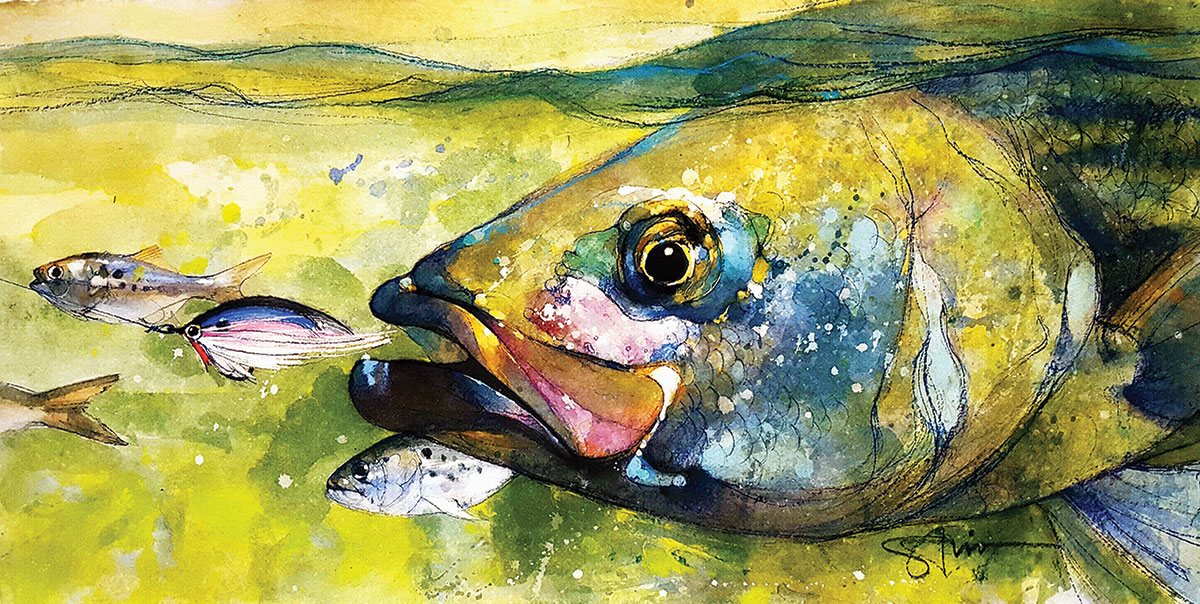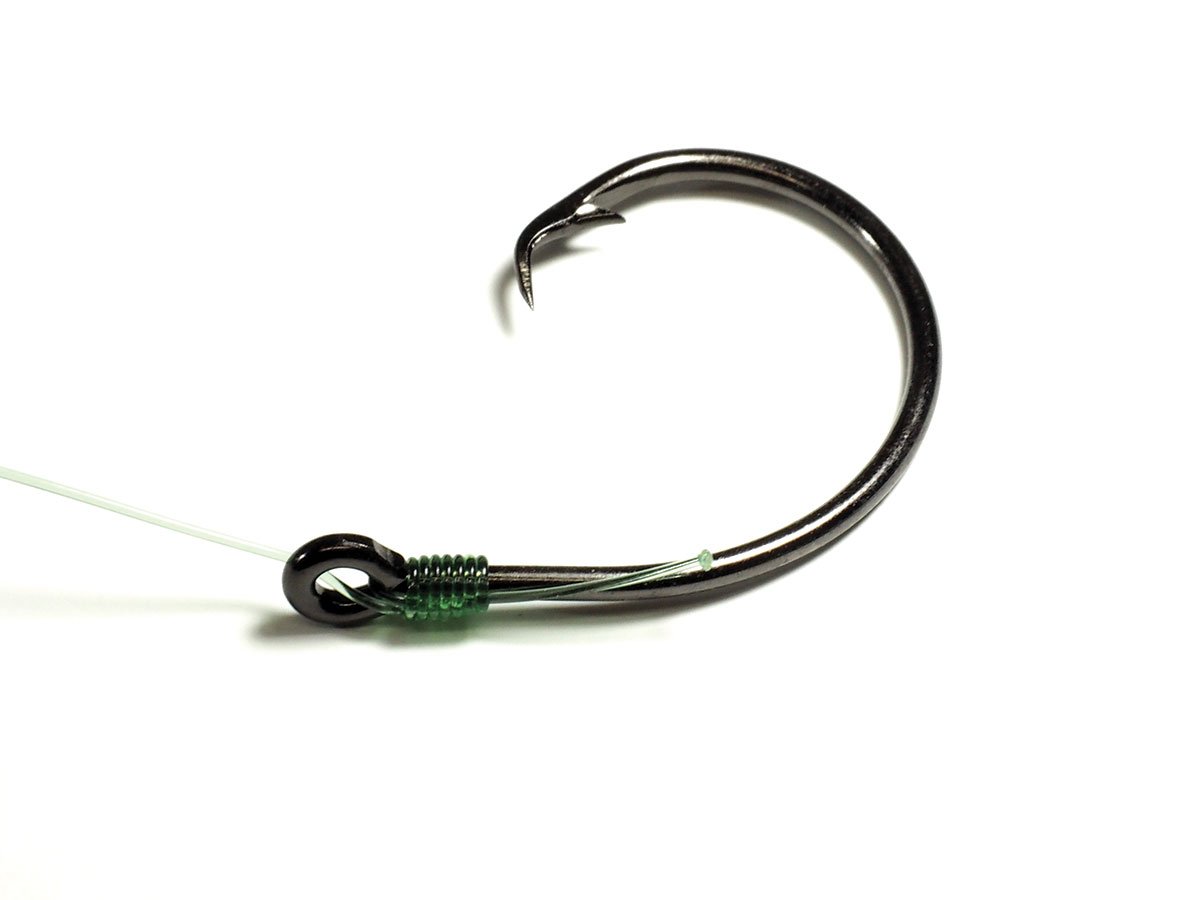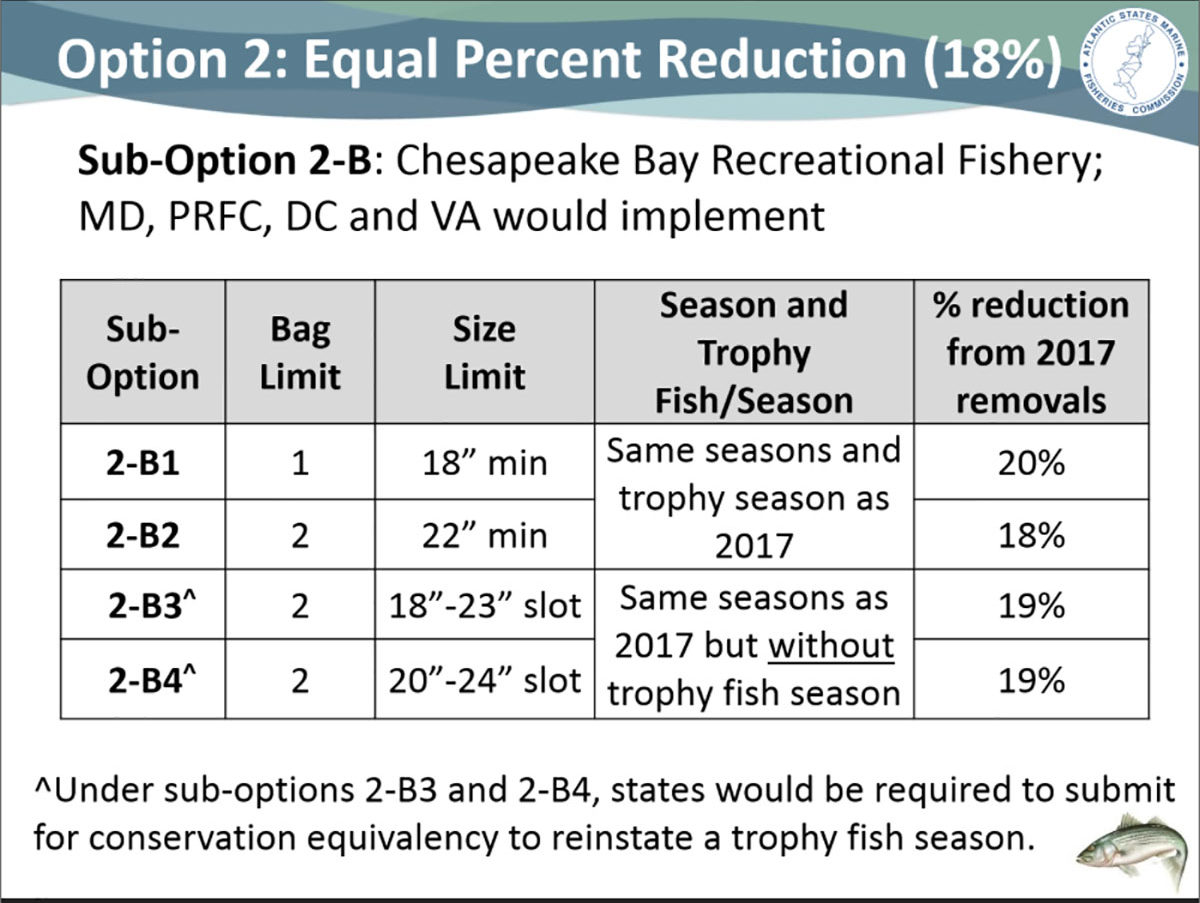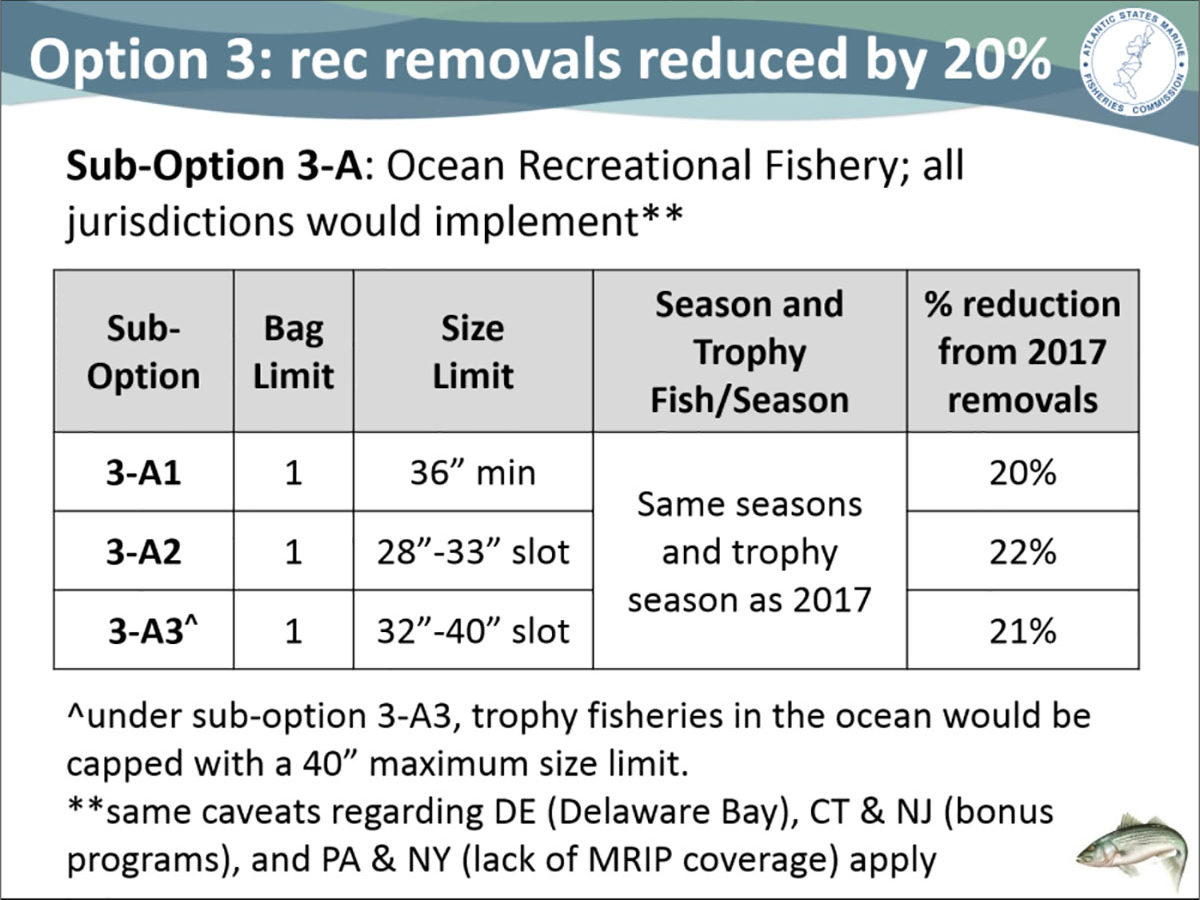
With the ASMFC considering mandatory use of circle hooks when bait fishing for striped bass in 2020, two of our editors relay their circle hook findings and how to make them work for you.
On Thursday, August 8, the Atlantic Striped Bass Management Board (Board) of the Atlantic States Marine Fisheries Commission (ASMFC) met as part of the annual Summer Meeting in Arlington, VA. On the agenda for the Board was to consider Draft Addendum VI for Public Comment; and to consider postponed motions from April 2019 to initiate an Amendment to the Atlantic Striped Bass Fishery Management Plan to address the needed consideration for change on the issues of fishery goals and objectives, empirical/biological/spatial reference points, management triggers, rebuilding biomass, and area-specific management.
|
|
|
The latter motion—initiating the Amendment to the Atlantic Striped Bass Fishery Management—was postponed once again to the Spring Meeting in May 2020 to allow time for the former motion to be addressed. Regarding the former motion, the Board approved Addendum VI for Public Comment. Addendum VI will revise coastwide commercial and recreational regulations to address overfishing. Included in the Addendum are three options, each with a set of sub-options. They are: Option 1/status quo, which would result in no change in management and allow fisheries to continue to operate under Addendum IV; Option 2, which implements equal (18%) reductions for both the commercial and recreational fisheries; and Option 3, which implements proportional reductions to the commercial fishery (1.8%) and recreational fishery (20%) based on annual harvest figures. Options 2 and 3 include a slate of specific management sub-options for consideration (see figure 1 and 2), and an additional set of sub-options will be available for the public comment period, which include a slot limit consisting of a harvest range with a minimum length of 30 inches and an as-to-be-determined maximum length. This maximum length is going to be determined by the Technical Committee and will be available prior to the public hearings. Please note that these options are for the ocean only, and fisheries inside the Chesapeake Bay have a different set of options that can be found at www.ASMFC.org and will be included in the public comment.
Further, as part of Addendum VI, the subject of mandatory circle hook use when using bait for striped bass was discussed, and three unique management options for their implementation are being considered. They are: Option A, Status Quo, which simply recommends that states promote the use of circle hooks to reduce discard mortality; Option B, mandatory implementation of the use of circle hooks; and Option C, mandatory promotion of the use of circle hooks by developing public education and outreach campaigns on their benefits. This last option would also require updates from each state on the public education and outreach efforts in annual state compliance reports.
Public Hearings on Addendum VI will be held in each state from Maine to North Carolina over the next several weeks. Stay tuned to www.TheFisherman.com for official announcement of the meeting dates, times and places as soon as they are available.

Jim Hutchinson, Jr. New Jersey/Delaware Bay Edition
During my trial and error with using circle hooks for stripers, I’ve found there are three primary reasons where issues arise, the first of course being the hookset. If you’re hauling back on the bite as if you’re on the televised bass circuit, you’re probably going to have failure. Unlike the j-hook, the circle hook is not designed solely to puncture flesh on contact, but its inward hook point is intended to catch the corner of the fish’s jaw, thereby decreasing mortality upon release. Keeping rods in rodholders (i.e., let Rodney hook your fish.) is one good way to train yourself in the subtleties of circle hook function.
A second major issue that anglers typically encounter with hooking fish comes from the actual rigging of their baits. The key to ensuring that the inward-turned hook point hits its mark is keeping the space from the hook point to the bend of the hook – also referred to as the gape or gap – free and clear. Burying a big chunk of bunker thereby covering the gap is sure to cause hardship (and I’ve learned that the hard way). A good way to get around that problem is by bridling your baits, be it with bread ties, thin wire, duo-locks, or specially designed bridles like the Ultimate Bait Bridle from 3D Fishing Products of Long Island (ultimatefishingfloat.info). Similar in design actually to the duo-lock snap, slip the stainless wire of the opened bridle through the snout or flesh of your bait, lock it in on the other side, then just place the hook point through the small, rubber-retaining band.
The third big problem with anglers finding circle hooks that work for the way they fish may actually be a little out of our own hands. There is no national standard on hook sizes; you could walk into any tackle shop and buy a package of 7/0 circle hooks for livelining mullet from five different manufacturers and find that each one, based on the manufacturers’ own designs, actually looks different in terms of size. Choosing say a 7/0 to 10/0 hook appropriate for stripers could be as much eye-balling at your local tackle shop as anything.
Years ago before the shark and billfish restrictions, some manufacturers were producing circle hooks with slightly offset hook points. That led to a lot of confusion amongst anglers converting to circles only to find that offset circle hooks were belly-hooking stripers as much as the j-hooks. When you lay a non-offset, inline circle hook down on a table it should lay flat. If it wobbles and rattles on the table-top when you touch it, it’s offset. A lot of wobble and you’ve got a gut-hooking machine for a hook. Quite honestly, with all the emphasis on reducing release mortality through gear restrictions, you really won’t find too many “non-offset” circle hooks on the market today.
The terms inline or non-offset are critical for anglers moving forward; during the spring striper spawn on the upper Chesapeake and stretches of the Delaware River every season, states have long required use of “non-offset circle hooks” to reduce catch and release mortality. More recently, Maryland and Massachusetts alike have expanded that ruling in coastal waters. All coastal states now require use of “non-stainless, non-offset circle hooks” when shark fishing. And in the billfish arena, non-offset, strictly inline circle hooks are required for HMS fishing; as such when you see the term “billfish approved” you can be assured that you have the real deal for reducing mortality on released striped bass as well.
As for that mortality decrease, when comparing five different circle hook studies from Massachusetts to North Carolina done over the past 10 years, the average mortality rate on striped bass caught and released on j-hooks was 11.8 percent compared to just 2.5 percent when using circle hooks, roughly an 80 percent improvement on overall mortality rates.
Toby Lapinski, New England Edition

I first tried circle hooks for striped bass fishing some 20 or so years ago. My initial testing was on live eels in the surf, and to say that my results were less than stellar is a bit of an understatement. Between continued gut-hooked fish, and the increased number of missed hits, my experiments were short-lived. Admittedly I know now that I did many things incorrectly—not using true circles, setting the hook like a j-hook, incorrect hook size, etc.—but still, it shouldn’t be that hard to make the change. I wrote circle hooks off as being “not for me” and went back to standard j-hooks for all my bait-related needs.
Fast-forward about a dozen years and I was into a good chunk bite for some big striped bass in the surf. I was happy with my catch success, but the one thing that my fishing partner and I could simply not let continue was the level of gut-hooked fish. Now before you assume that I was spiking a rod and letting the chunk soak while I swigged beer from the comfort of my beach chair, setting up on the fish after it had mouthed the chunk for who knows how long, I will stop you to say this was active chunking. The rod never left my hand, and I set the hook within moments of the initial pick-up. I was doing all that I could to reduce damage on the fish, but it was just not working out well.
It was my fishing partner, Jay Hanecak, who first began experimenting with circles. He found some excellent 10/0 Mustad hooks (Model 39950NP-BN) that were designed for billfish and they worked like a charm. Both of our hook-up ratios actually increased, and I do not recall a single deep-hooked fish. The major drawback to these hooks was the price; at $1 per hook it didn’t take losing too many hooks to bluefish, dogfish and snags to cause me to look for alternatives. They were also rather difficult to source as no one carried them locally being that they were not really designed for our fishery. After a lengthy and rather expensive string of ill-advised purchases, I eventually found another hook from Mustad (Model 39944-BN) to fit the bill. In size 10/0, this is my current go-to chunking hook.
With Massachusetts already implementing a circle hook requirement for private anglers beginning in 2020, this season I set out to find a suitable circle hook for eeling. Using what I had learned about hook sizes when searching for the right chunking hook, the hunt was much more efficient this time around and I’ve been quite pleased with my success on the Gamakatsu inline octopus circle hooks (Model #360416.) The 6/0 size does well on medium-sized eels, but I plan to step up to a 7/0 or even 8/0 for larger eels.
When selecting a circle hook I look for several key factors. First and foremost I want an inline circle. If a hook has an offset point then it is not, in fact, a true circle and therefore does not meet circle hook requirements in tournaments, management criteria, etc. Second, I want a hook with a very large gap from hook point to shank. If a bait blocks the gap then the hook cannot function properly. Third, I look for a hook with a straight, not up- or down-turned eye. By attaching my leader to the circle hook with a Power Snell (See the photo here and video at www.TheFisherman.com), and ensuring that the line comes out the eye of the hook on the side of the hook’s point, any pulling back on the line serves to both help set the hook initially and keep the fish hooked.
So yes, by the commencement of the 2020 striped bass fishing season there is a distinct possibility that the mandatory use of circle hooks for striped bass will be implemented coast-wide (It has already been implemented for next season in Massachusetts and is in effect in Maryland when fishing bait in the Chesapeake Bay and its tidal tributaries.) So let’s circle the wagons, get onboard and start using circle hooks any time bait is used for striped bass. The writing is on the wall that their use is imminent; the sooner you make the change the smoother the transition will be.





